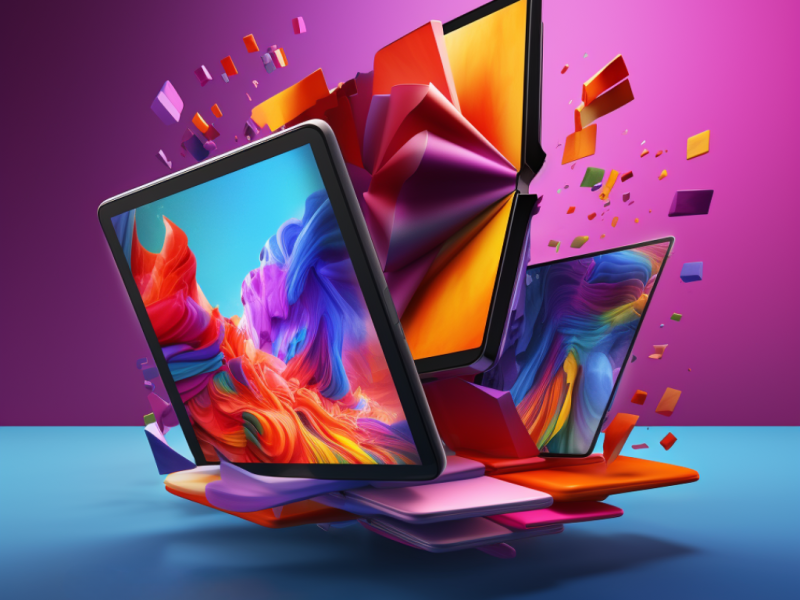The mobile industry’s new frontier is bendable, foldable, and unmistakably revolutionary. Welcome to the era of foldable devices, where the synergy of smartphones and tablets unfolds—quite literally—into our hands.
In the heart of Silicon Valley and beyond, a quiet revolution is taking shape. Engineers and designers at the world’s leading tech companies are reimagining the future—one where the rigid screens of yesteryear bend to the contours of innovation. As foldable phones gain popularity, they bring with them a set of challenges and opportunities that are transforming the app development landscape.
A Brief History of Screen Evolution
From the brick-like phones of the 1980s to the sleek touchscreens that dominate today’s market, mobile devices have undergone a radical transformation. Now, as we stand on the brink of a new shift, foldable devices offer a tantalizing glimpse into a flexible future. They promise the portability of a phone with the expansive display of a tablet, and the market is taking notice. Consumers, intrigued by the novelty and utility, are beginning to embrace foldable technology.
The Developer’s Dilemma – Adapting to a Foldable World
App developers are now navigating uncharted waters with the advent of foldable devices. The usual paradigms of screen uniformity and static design no longer apply, giving way to a new set of challenges that demand innovation and agility. As devices fold and unfold, the apps must follow suit, maintaining their functionality and aesthetic appeal across a variety of form factors. This requires a deep understanding of both hardware constraints and user interactions. The developers’ dilemma has sparked a creative renaissance, as they seek to craft applications that are not only compatible with foldable screens but also enhance the unique capabilities of these transformative gadgets. In doing so, they are rewriting the rulebook of app design, creating seamless experiences that accommodate the fluidity of foldable technology.
The Tools of Transformation – Shaping Apps to Fit
The toolbox for developers is rapidly expanding as the foldable device ecosystem grows. New software development kits (SDKs) and responsive design methodologies are being created specifically with foldability in mind. These tools are designed to streamline the process of making apps versatile, ensuring they can elegantly adapt to the varying screen real estate without compromising on functionality. Developers are now empowered to experiment with multi-window applications and transitions that were previously impossible, pushing the boundaries of what an app can do. This toolkit is not just about scaling up or down; it’s about reimagining the user interface to leverage the unique features of foldable devices, such as multi-active windows and drag-and-drop capabilities between screens. As these tools mature, they will define the standard for foldable-friendly apps, heralding a new age of app development that is as dynamic as the devices themselves.
User Experience Reimagined – Designing for the Fold
In the realm of foldable devices, the user experience (UX) takes on a new level of complexity and creativity. Designers must account for the myriad ways in which a device can be folded, flipped, and turned, each configuration presenting its own UX opportunities and challenges. This multifaceted design landscape calls for a reimagined approach to UX—one that prioritizes intuitive navigation, contextual awareness, and visual consistency across diverse screen states. By considering factors like the placement of foldable hinges, the transition between single and dual-screen usage, and the tactile feedback of physical folding, designers can craft experiences that feel natural and effortless. The goal is to create a UX that harmonizes with the physicality of foldable devices, providing users with a sense of fluidity and cohesion as they interact with their digital world in a more tangible way.
Looking to the Horizon – What the Future Holds
The horizon for foldable devices shimmers with potential, signaling a transformative shift in how we conceive of and interact with our mobile technology. As these devices become more prevalent, the onus falls on developers and manufacturers to ensure that the software keeps pace with the hardware. The future portends a landscape where apps are not just designed to be used on a foldable device but are envisioned from the ground up to exploit its unique advantages. We are likely to witness the emergence of new app genres and user behaviors tailored to these versatile form factors. Moreover, as foldable devices continue to merge the gap between mobile phones and larger computing platforms, we might see them becoming the centerpiece of a new, more mobile-centric computing paradigm. With each crease and curve, foldable technology invites us to rethink and retool, setting the stage for a future where our digital experiences are as boundless as our imaginations.
A Call to Innovation
The foldable device revolution is just beginning, and the call to innovation has never been clearer. Developers and designers have the opportunity to redefine app development, crafting experiences that are not only functional but also flexible and delightful. As we embrace the possibilities of foldable devices, the future of mobile technology has never looked more expansive—or more exciting.
We’d love to hear from you! Whether you’re looking to update your existing app or create a new one from scratch, our developers are ready to help you leverage the full potential of foldable screens. Connect with us to discover how we can transform your ideas into reality with apps that flex, fold, and flourish.

